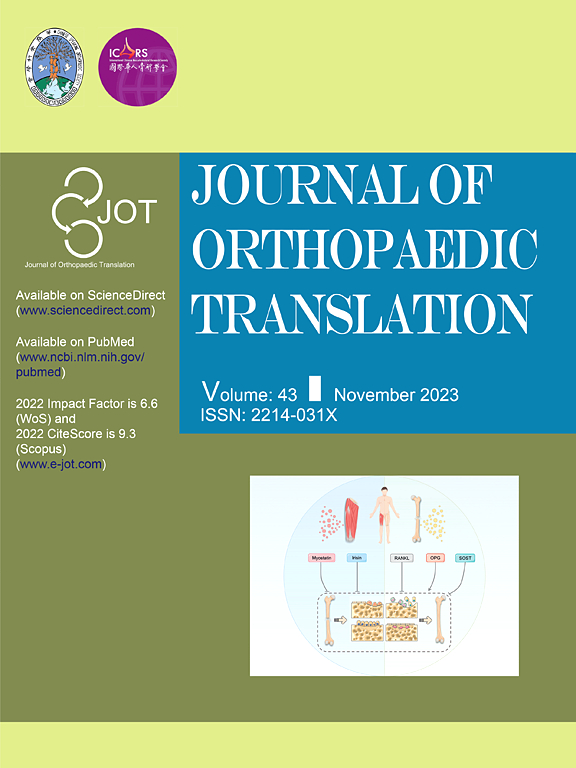Osteoclast-derived apoptotic bodies accelerate the pathological progression of osteoarthritis via disturbing subchondral bone remodeling
IF 5.9
1区 医学
Q1 ORTHOPEDICS
引用次数: 0
Abstract
Objective
To investigate the role of osteoclast-derived apoptotic bodies (OC-ABs) in osteoarthritis (OA), specifically their impact on subchondral bone remodeling and disease progression, and to explore potential therapeutic strategies targeting OC-AB-induced pathways.
Methods
We utilized a mouse model of anterior cruciate ligament transection (ACLT) to simulate post-traumatic osteoarthritis (PTOA). Levels of OC-ABs were assessed in subchondral bone and correlated with OA severity. Additionally, apoptotic body-deficient MRL/lpr mice were analyzed to evaluate the direct contribution of OC-ABs to OA progression and subchondral bone remodeling. The involvement of OC-ABs in osteogenesis was further examined using mesenchymal stem cells (MSCs), with a focus on the RANKL reverse signaling pathway. The therapeutic potential of rapamycin to counteract OC-AB effects was tested.
Results
Increased OC-AB accumulation in subchondral bone was positively correlated with OA severity in ACLT-induced mice. Apoptotic body-deficient MRL/lpr mice demonstrated slower OA progression and maintained more stable subchondral bone architecture, indicating a pathogenic role of OC-ABs in OA. OC-ABs significantly stimulated osteogenesis in MSCs via the RANKL reverse signaling pathway. Treatment with rapamycin effectively reversed OC-AB-induced subchondral bone formation, mitigated OA progression, and inhibited the RANKL reverse signaling pathway.
Conclusion
OC-ABs play a critical role in exacerbating OA by promoting subchondral bone remodeling via the RANKL reverse signaling pathway. Rapamycin presents as a promising therapeutic agent capable of mitigating OC-AB-driven pathology, highlighting new avenues for targeted OA treatment.

破骨细胞衍生的凋亡小体通过干扰软骨下骨重塑加速骨关节炎的病理进展
目的探讨破骨细胞来源的凋亡小体(OC-ABs)在骨关节炎(OA)中的作用,特别是它们对软骨下骨重塑和疾病进展的影响,并探讨针对oc - ab诱导通路的潜在治疗策略。方法采用小鼠前交叉韧带横断(ACLT)模型模拟外伤性骨关节炎(PTOA)。评估软骨下骨OC-ABs水平并与OA严重程度相关。此外,对凋亡体缺陷MRL/lpr小鼠进行分析,以评估OC-ABs对OA进展和软骨下骨重塑的直接贡献。利用间充质干细胞(MSCs)进一步研究OC-ABs在成骨过程中的作用,重点关注RANKL反向信号通路。检测雷帕霉素对OC-AB效应的治疗潜力。结果aclt诱导小鼠软骨下骨OC-AB积累增加与OA严重程度呈正相关。凋亡体缺陷MRL/lpr小鼠表现出OA进展较慢,并保持更稳定的软骨下骨结构,表明OC-ABs在OA中的致病作用。OC-ABs通过RANKL反向信号通路显著刺激MSCs成骨。雷帕霉素治疗有效逆转oc - ab诱导的软骨下骨形成,减缓OA进展,抑制RANKL反向信号通路。结论oc - abs通过RANKL反向信号通路促进软骨下骨重塑,在骨性关节炎加重中起关键作用。雷帕霉素是一种有前景的治疗药物,能够减轻oc - ab驱动的病理,突出了靶向OA治疗的新途径。
本文章由计算机程序翻译,如有差异,请以英文原文为准。
求助全文
约1分钟内获得全文
求助全文
来源期刊

Journal of Orthopaedic Translation
Medicine-Orthopedics and Sports Medicine
CiteScore
11.80
自引率
13.60%
发文量
91
审稿时长
29 days
期刊介绍:
The Journal of Orthopaedic Translation (JOT) is the official peer-reviewed, open access journal of the Chinese Speaking Orthopaedic Society (CSOS) and the International Chinese Musculoskeletal Research Society (ICMRS). It is published quarterly, in January, April, July and October, by Elsevier.
 求助内容:
求助内容: 应助结果提醒方式:
应助结果提醒方式:


